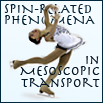Speaker
Leonid Rokhinson
Description
In 1928 Dirac reconciled quantum mechanics and special
relativity in a set of coupled equations which became the
cornerstone of quantum mechanics. Its main prediction that
every elementary particle has a complex conjugate
counterpart – an antiparticle – has been confirmed by
numerous experiments. A decade later Majorana showed that
Dirac's equation for spin-1/2 particles can be modified to
permit real wavefunctions. The complex conjugate of a real
number is the number itself, which means that such particles
are their own antiparticles. The most intriguing feature of
Majorana particles is that in low dimensions they obey
non-Abelian statistics and can be used to realize quantum
gates that are topologically protected from local sources of
decoherence. While the search for Majorana fermions among
elementary particles is still ongoing, excitations sharing
their properties may emerge in electronic systems.
Specifically, it has been predicted that Majorana
excitations may be formed in some unconventional states of
matter. I will report the observation of the fractional ac
Josephson effect in a hybrid semiconductor/superconductor
InSb/Nb nanowire junction, a hallmark of topological matter.
When the junction is irradiated with rf frequency f at zero
external magnetic field, quantized voltage steps (Shapiro
steps) with a height ΔV=hf/2e are observed, as is expected
for conventional superconductor junctions where the
supercurrent is carried by charge-2e Cooper pairs. At high
fields the height of the first Shapiro step is doubled to
hf/e, suggesting that the supercurrent is carried by
charge-e quasiparticles. This is a unique signature of
Majorana fermions, elusive particles predicted ca. 80 years ago.

